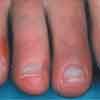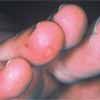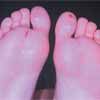An Adolescent Girl With Painful Purple Papules
This adolescent girl presents with painful purple papules that have developed on her toes. These papules are making it impossible for her to wear her "fashion" shoes to school in the late fall and early winter. She reports that her feet have been cold for as long as she can remember and that she is not bothered by it. She is otherwise healthy, takes no medications, and does not smoke.

Figure 1

Figure 2
Case 1:
This adolescent girl presents with painful purple papules that have developed on her toes. These papules are making it impossible for her to wear her ;fashion; shoes to school in the late fall and early winter. She reports that her feet have been cold for as long as she can remember and that she is not bothered by it. She is otherwise healthy, takes no medications, and does not smoke.
Are these lesions a sign of a serious underlying illness? Why does the problem seem to be noticeable in the late fall and early winter?

Figure 1

Figure 2
Case 1: Chilblains (pernio) refers to a ;benign; inflammatory process that produces painful, burning violaceous papules on the toes. This condition occurs in the setting of ;cold; toes, which may or may not be erythrocyanotic. The trigger is cold, wet, nonfreezing weather that adolescents don't acknowledge and for which they don't change their footwear for protection. The acute form is typically seen in adolescence as repeated episodes of painful inflammation that last 10 to 14 days.
Histologic evaluation of these papules shows epidermal pallor, a superficial and deep perivascular lymphocytic infiltrate that occurs around the eccrine coils, and a characteristic papillary dermal edema. Classic chilblains is not usually associated with any detectable cold-associated proteins. The main differential diagnoses are chilblains lupus and cold-sensitive blood dyscrasias. Bloodwork looking for evidence of autoimmunity and cold-sensitive dysproteinemias should be considered for patients whose presentation is atypical or prolonged.
The best therapy for chilblains is to keep the feet warm with footwear appropriate for the climate. It is not surprising that this condition is most commonly seen in young women during the ;shoulder seasons,; when it is still not cold enough to require full protection. The challenge for us is to convince the patient to choose footwear that is more appropriate than fashionable. I also ask affected patients to wear ;house shoes; and, possibly, socks at night so that they keep their feet continuously warm.
Your treatment will fail if you cannot convince these adolescents to keep their feet warm. If they can do so, high-potency topical corticosteroids will reduce the inflammation and the pain. In recalcitrant cases, nifedipine has been effective. The lesions resolve without scarring but will recur with further exposure to the cold.

Case 2:
This child presents with painful, cracked feet that limit his ability to play sports with his friends. It has been a problem for years, and his parents are looking to cure it once and for all.
Is this an allergy to his athletic shoes? Is there something lacking in his diet?

Case 2: Juvenile plantar dermatosis (JPD) produces a ;glazed; erythema of the soles, usually limited to the forefoot. The condition is associated with scaling, painful hyperkeratosis and fissures that are accentuated in the flexural creases of the toes and on the weight-bearing areas. JPD is often present in atopic children (in whom the disorder is often relatively difficult to control), but it is not limited to them.
JPD produces a distinct morphology that does not require further testing. Tinea pedis is unusual in children and, if present, will have associated findings in the web spaces, the dorsal foot, and the nail plates--all of which are spared in JPD.
A contact allergy to footwear would be a logical thought. As a rule, however, the dorsal aspect of the foot is involved. In the case of a reaction to a material in the in-sole of the shoe, the involvement is not likely to be accentuated on the forefoot. Also, contact allergy commonly presents as a blistering morphology.
The best ;bedside; test is to feel the child's sock to see whether it is damp. The etiology of JPD is unknown, but I subscribe to the theory that the cutaneous changes result from rapid drying of the skin after continuous saturation in footwear. The condition could just as easily be called ;running shoe dermatitis,; ;rubber boot dermatitis,; or ;snow boot dermatitis; (ie, occlusive footwear) depending on your specific locale and the time of year of the disease flare.
I have not seen this condition develop in persons who restrict their footwear to sandals, but our sandal season in Canada is short.
JPD is a chronic condition that persists year-round. Flares occur depending on the skin's local environment. There is generally a dramatic improvement during puberty; the condition rarely persists into adulthood.
I recommend that patients keep their feet as dry as possible. This means wearing fresh cotton socks, leather shoes, a second boot liner for alternate-day use and, when possible, the wearing of ;breathable; shoes. I ask parents to apply an emollient to the skin as soon as the footwear is removed in an attempt to maintain the hydration of the skin and reduce the rapidity of the evaporation.
I also recommend twice-daily applications of a midstrength topical corticosteroid to inflamed areas to reduce the hyperkeratosis and fissuring. If fissuring has already occurred, I ask parents to apply a methylmethacrylate glue to ;caulk; the fissures. This reduces the pain dramatically while we intensify our efforts to apply the emollients and topical corticosteroid.
Newsletter
Access practical, evidence-based guidance to support better care for our youngest patients. Join our email list for the latest clinical updates.